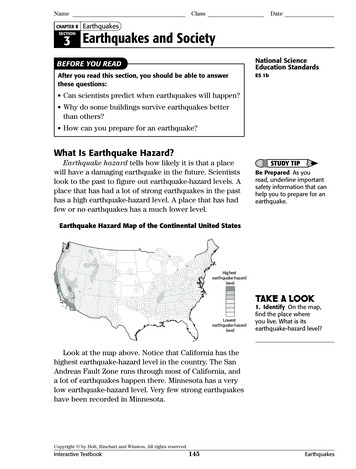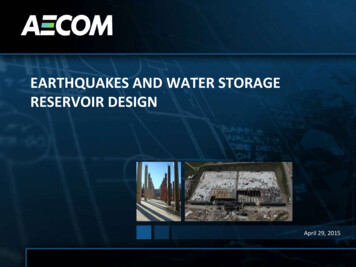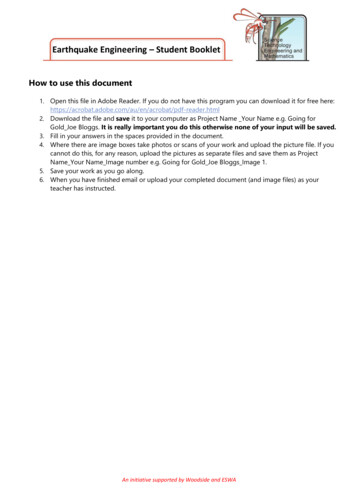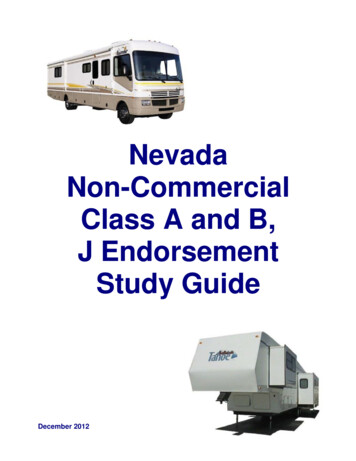
Transcription
NameCHAPTER 8ClassDateEarthquakesSECTION3 Earthquakes and SocietyNational ScienceEducation StandardsBEFORE YOU READAfter you read this section, you should be able to answerthese questions:ES 1b Can scientists predict when earthquakes will happen? Why do some buildings survive earthquakes betterthan others? How can you prepare for an earthquake?What Is Earthquake Hazard?Earthquake hazard tells how likely it is that a placewill have a damaging earthquake in the future. Scientistslook to the past to figure out earthquake-hazard levels. Aplace that has had a lot of strong earthquakes in the pasthas a high earthquake-hazard level. A place that has hadfew or no earthquakes has a much lower level.STUDY TIPBe Prepared As youread, underline importantsafety information that canhelp you to prepare for anearthquake.Earthquake Hazard Map of the Continental United StatesHighestearthquake-hazardlevelTAKE A LOOKLowestearthquake-hazardlevel1. Identify On the map,find the place whereyou live. What is itsearthquake-hazard level?Look at the map above. Notice that California has thehighest earthquake-hazard level in the country. The SanAndreas Fault Zone runs through most of California, anda lot of earthquakes happen there. Minnesota has a verylow earthquake-hazard level. Very few strong earthquakeshave been recorded in Minnesota.Copyright by Holt, Rinehart and Winston. All rights reserved.Interactive Textbook145Earthquakes
NameSECTION 3ClassDateEarthquakes and Society continuedCan Scientists Predict Earthquakes?You know that earthquakes have different magnitudes.You can probably guess that earthquakes don’t happenon a set schedule. But what you may not know is that thestrength of earthquakes is related to how often they happen.Scientists can’t predict earthquakes. However, bylooking at how often earthquakes have happened in thepast, they can estimate where and when an earthquake islikely to happen.Look at the table below. It shows the number of earthquakes of different sizes that happen every year. Thereare many more weak earthquakes than strong earthquakes every year.Math Focus2. Calculate About how manytimes more light earthquakesthan strong earthquakeshappen every year?DescriptionMagnitude on theRichter scaleAverage numberper yearGreat8.0 and higherMajor7.0 to 7.918Strong6.0 to 6.9120Moderate5.0 to 5.9800Light4.0 to 4.96,200Minor3.0 to 3.949,000Very minor2.0 to 2.9365,0001Scientists can guess when an earthquake will happenby looking at how many have happened in the past. Forexample, if only a few strong earthquakes have happenedrecently in an earthquake zone, scientists can guess thata strong earthquake will happen there soon.Critical Thinking3. Apply Concepts Whatdo you think makes strongearthquakes more likely tohappen in seismic gaps?What Is the Gap Hypothesis?Some faults are very active. They have a lot of earthquakesevery year. These faults sometimes have very strongearthquakes. A part of an active fault that hasn’t had a strongearthquake in a long time is called a seismic gap.The gap hypothesis says that if an active fault hasn’thad a strong earthquake in a long time, it is likely to haveone soon. In other words, it says that strong earthquakesare more likely to happen in seismic gaps.Copyright by Holt, Rinehart and Winston. All rights reserved.Interactive Textbook146Earthquakes
NameSECTION 3ClassDateEarthquakes and Society continuedHow Do Earthquakes Affect Buildings?Have you ever seen pictures of a city after a strongearthquake has hit? You may have noticed that somebuildings don’t have very much damage. Other buildings,however, are totally destroyed. Engineers can study thedamage to learn how to make buildings that are strongerand safer.Critical Thinking4. List Give three factorsthat can affect how much abuilding will be damaged byan earthquake.A mass damper is aweight that is placed inthe roof of a building.Computers can sensewhen the building ismoving. The computersmove the mass damperaround to help keepthe building frommoving too much.Steel cross braces arefound between thefloors in a building.They help to keep thebuilding from breakingwhen it moves fromside to side.Flexible pipes canhelp to prevent waterlines and gas linesfrom breaking. Thepipes can bend andtwist without breaking.TAKE A LOOKAn active tendon system is like amass damper, except it is placedunder the building.5. Compare How is a massdamper different from anactive tendon system?Base isolators can absorb energyduring an earthquake. They keepseismic waves from moving throughthe building. Base isolators aremade of rubber, steel, and lead.Copyright by Holt, Rinehart and Winston. All rights reserved.Interactive Textbook147Earthquakes
NameSECTION 3ClassDateEarthquakes and Society continuedHow Can You Prepare for an Earthquake?READING CHECK6. Explain Why is itimportant to make andpractice an earthquake plan?If you live in a place where earthquakes happen often,you and your family should have an earthquake plan. Youshould practice your plan so you will be prepared if anearthquake happens.How Can You Make an Earthquake Plan?There are several things to include in your earthquakeplan.SAFE HOMEPut heavy things near the floor so that they do not fallduring an earthquake. Make sure things that can burn arekept away from electric wires and other things that canstart a fire.SAFE PLACES IN YOUR HOMEREADING CHECK7. Identify Think aboutyour bedroom. Write downa safe place in your bedroomthat you can go during anearthquake.Make sure you know a safe place in each room in yourhome. Safe places are areas far from windows or heavyobjects that could fall or break.PLAN TO MEET OTHERSTalk to your family, friends, or neighbors and set up aplace where you all will meet after an earthquake. If youall know where to meet one another, it will be easy tomake sure that everyone is safe.EARTHQUAKE KITYour earthquake kit should have things that you mightneed after an earthquake. Remember that you may nothave electricity or running water after an earthquake.TAKE A LOOK8. List List four foods thatwould be useful to have in anearthquake kit.What Should Be in an Earthquake Kit water food that won’t go bad a fire extinguisher a flashlight with batteries a small radio that runson batteries extra batteries for the radioand flashlight medicines a first-aid kitCopyright by Holt, Rinehart and Winston. All rights reserved.Interactive Textbook148Earthquakes
NameSECTION 3ClassDateEarthquakes and Society continuedWhat Should You Do During an Earthquake?If you are inside when an earthquake happens, crouchor lie facedown under a table or a desk. Make sure youare far away from windows or heavy objects that mightfall. Cover your head with your hands.If you are outside during an earthquake, lie face downon the ground. Make sure you are far from buildings,power lines, and trees. Cover your head with your hands.If you are in a car or bus, you should ask the driver tostop. Everyone should stay inside the car or bus until theearthquake is over.READING CHECK9. List Look around yourclassroom. List two placesthat you could go in case ofan earthquake.Say ItShare Experiences Have youever been in an earthquake?In a small group, talk aboutwhat it was like.What Should You Do After an Earthquake?Being in an earthquake can be scary. After an earthquakehappens, people are often confused about what happened.They may not know what to do or where to go.After an earthquake, try to stay calm. Look around you.If you are near something dangerous, like a power line orbroken glass, get away as quickly as you can. Never go intoa building after an earthquake until your parent, a teacher, apolice officer, or a firefighter tells you it is safe.Always remember that there could be aftershocks.Aftershocks are weaker earthquakes that can happenafter a large earthquake. Even though they are weakerthan the main earthquake, aftershocks can still be verystrong and damaging.Stick to your earthquake plan. Stay together with yourfamily or friends so that they know you are safe.READING CHECK10. Identify Who shouldyou ask if you want to knowwhether it is safe to goback into a building afteran earthquake?Copyright by Holt, Rinehart and Winston. All rights reserved.Interactive Textbook149Earthquakes
NameClassSection 3 ReviewDateNSESES 1bSECTION VOCABULARYgap hypothesis a hypothesis that is based onthe idea that a major earthquake is more likelyto occur along the part of an active fault whereno earthquakes have occurred for a certainperiod of timeseismic gap an area along a fault whererelatively few earthquakes have occurredrecently but where strong earthquakes haveoccurred in the past1. Identify Why are seismologists interested in seismic gaps?2. Describe Fill in the chart below to show what you should do during an earthquake.If you are.Then you should.inside a building.lie face down on the ground with your hands on your head, farfrom power lines or fire hazards.in a car or bus3. Identify What do engineers do to learn how to make a building more likely tosurvive an earthquake?4. Identify Relationships What is the relationship between the strength of anearthquake and how often it occurs?5. Infer In most cases, you should stay inside a car or a bus in an earthquake. Whenmight it be best to leave a car or a bus during an earthquake?Copyright by Holt, Rinehart and Winston. All rights reserved.Interactive Textbook150Earthquakes
Earth Science Answer Key continuedSECTION 3 EARTHQUAKES AND SOCIETY7. Water: More water makes explosive1. Answers will vary.2. about 50 times more3. If an active fault hasn’t had a strong earthquake4.5.6.7.8.9.10.8.9.in a long time, pressure is building up. Morepressure leads to stronger earthquakes.height, mass, composition, locationA mass damper is placed at the top of a building. An active tendon system is in its basement.You will know what to do in an earthquake.Possible answers: doorway, under a desk ortableany nonperishable foodPossible answers: under the desk, in thedoorwaya parent, teacher, police officer, or firefighter10.11.Review1. Lava is magma that flows on the Earth’ssurface.2. explosive and nonexplosive3. Magma with a lot of water is likely to erupt4.Review1. Earthquakes are more likely to occur in seis-5.mic gaps than in other places.2.If you are.Then you should.inside abuilding.crouch or lie face down under a desk ortable, away from glass or heavy objects;cover your head with your hands.outside.lie face down on the ground with yourhands on your head, far from powerlines or fire hazards8.ask the driver to pull over and stop;stay inside the car or bus until theearthquake is over9.in a caror buseruptions more likely.Silica: More silica makes explosiveeruptions more likely.hardened magma that is blasted into the airThey both have sharp edges.Small pieces of lava harden before they hitthe ground.about 120 mi/h6.7.explosively.It is thinner and runnier, so gases can escapemore easily.Both are lava flows with smooth surfaces.Pillow lava forms underwater. Pahoehoeforms on land.Large blobs of magma harden in the air.Pressure builds up inside bubbles in magma.When the pressure gets high enough, the bubbles shatter, producing tiny fragments of rock.a fast-moving “river” of hot ash and dustfrom a volcanoexplosiveSECTION 2 EFFECTS OF VOLCANICERUPTIONS3. They look at the damage to other buildingsfrom earthquakes.4. Small earthquakes occur much more oftenthan large earthquakes.5. Possible answers: The car is on fire; the car isin a dangerous location (e.g., railroad tracks).1. Ash and dust in the atmosphere block2.Chapter 9 Volcanoes3.4.5.6.7.SECTION 1 VOLCANIC ERUPTIONS1.2.3.4.a body of magma below a volcanohardened lava flowsnonexplosiveExplosive eruptions are less common.Explosive eruptions produce ash and dustinstead of lava.5. magma composition6. It can block the volcano’s vents, causingpressure to build up.sunlight, preventing it from reachingEarth’s surface.Layers of lava from nonexplosive eruptionsbuild up into a mountain.pyroclastic materialexplosive eruptionsThey are made of layers of different materials.ash and lavaa funnel-shaped pit around the central ventof a volcanoReview1. A crater is a funnel-shaped pit around the cen-tral vent at the top of a volcano. A caldera is alarge semicircular depression that forms whenthe magma chamber of a volcano collapses.Copyright by Holt, Rinehart and Winston. All rights reserved.Interactive Textbook Answer Key44Earth Science
times more light earthquakes than strong earthquakes happen every year? Critical Thinking 3. Apply Concepts What do you think makes strong earthquakes more likely to happen in seismic gaps? Can Scientists Predict Earthquakes? You know that earthquakes have different magnitudes. You can probably guess that earthquakes don't happen on a set .










